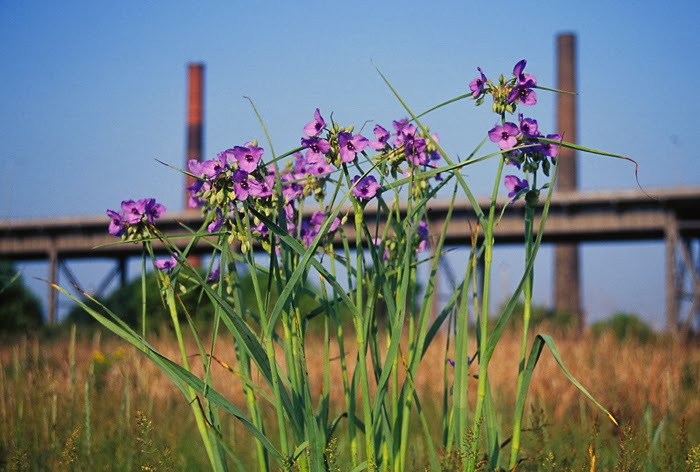A local artist holds a water vigil in solidarity with West
Virginia following the chemical spill.
Melanie was waiting when I double-parked in the
small lot next to the Milwaukee River Bridge in the Third Ward. Her breath came
out like a cloud as I approached. But with rosy cheeks and a buoyant spirit she
greeted me cheerfully despite her wait in the –11° wind chill. Near the end of Milwaukee’s
Riverwalk she had set up a shrine on a small silvery table. The location, where
the Menomonee River meets the Milwaukee, was chosen to maximize the symbolism
of the vigil for which the shrine was intended.
Because of the frigid conditions, the ceremony was
brief and simple. Melanie knelt beside the shrine and stretched out a string of
hand-printed prayer flags she had made for the occasion while I composed a few
shots to document the vigil. Although no one else joined in, we were not alone
on the river. We noted with curiosity the presence of ducks in a patch of open
water. A pair of mallards and another of mergansers floated amid the steam
rising off the river. Farther upstream a team of four coast guards were
practicing winter water rescue from a hole they had cut in the solid ice.
Before I arrived Melanie had witnessed the passing
of the barge that delivers coal to the We Energies Menomonee Valley Power
Plant, taking note of the irony.
Melanie Ariens had invited me to
participate and to document her Water Vigil. Nationally, the vigil was
organized by 350.org, the global environmental activism organization founded by
author Bill McKibben. On Tuesday, January 21 people around the country and the
world were invited to “join in solidarity with West Virginians; to honor and
protect all water!”
West Virginia, of course, is where a recent chemical
spill polluted the Elk River so badly that tap water was shut down for
thousands of residents in the capitol city of Charleston. A coal company was
responsible for the spill.
Melanie told me, “I felt the need to participate in this vigil to show support from
Milwaukee for those affected by the spill into the Elk River. It was the
very small thing I could do. Imagine shutting down the water supply to
Milwaukee for an extended period due to a chemical spill, then being told the
water is ok, with only traces of the chemical in it. How would that make
you feel about drinking it or bathing your child in it? It is a real
statement of how unregulated and untested the chemical industry is.”
Melanie Ariens
is not new to this combination of art and activism. A self-proclaimed “multi media artist,
environmental advocate and volunteer community coordinator,” Ariens bills
herself as an environmental artist. She has used the water shrine previously as
an installation in other local waterways. She has a portfolio of digital images
depicting a glass half full (or…?) on the Lake Michigan shoreline and in a
variety of streams and other bodies of water. One of her best-known works is a
wall-sized rendering of the Great Lakes in denim.
In her own
words, “I make shrines, prayer flags, and other artwork as a way to honor the
Great Lakes and freshwater. Making the work is a meditation for me, and
hopefully an unusual presentation of an idea to get people to reflect on how
important water is to life, and importantly to be stewards of this amazing
resource.”
Ariens is both
passionate and well versed on her issues. About the current vigil she said, “I
know from the many years I have worked on pesticide reform that just because a
chemical is listed with the EPA—in this case, 4-methylcyclohexane methanol—doesn't
mean it has been tested; it just means they know it is out there. If we as
individuals don't speak up and fiercely protect our water, abuse and
contamination will happen.”
Ariens has a Bachelor of Fine Arts Degree from UWM, where she
specialized in painting, drawing and printmaking. Now her work frequently
includes multi media and installations. When not out in
the landscape, she can be found at RedLine, Milwaukee where she is among the Artists-in-Residence.
After about ten minutes at the shrine my gloved fingers were
stingingly numb; my face and feet not far behind. Melanie, who had been there a
half-hour longer, was holding her prayer flags without gloves. Her enthusiasm
never flagged however and her smile was radiant. When we finished and started
to disassemble the shrine we discovered that the half-full glasses of water had
frozen to the surface. We pried them loose and tossed the remaining water into
the river below.
In addition to posting them here and on Facebook, two of our
images have been uploaded to a flickr page set up by 350.org to demonstrate
solidarity and share the spirit of the event. When I checked just before
posting this there were 182 images on the site. To see them click here.
























